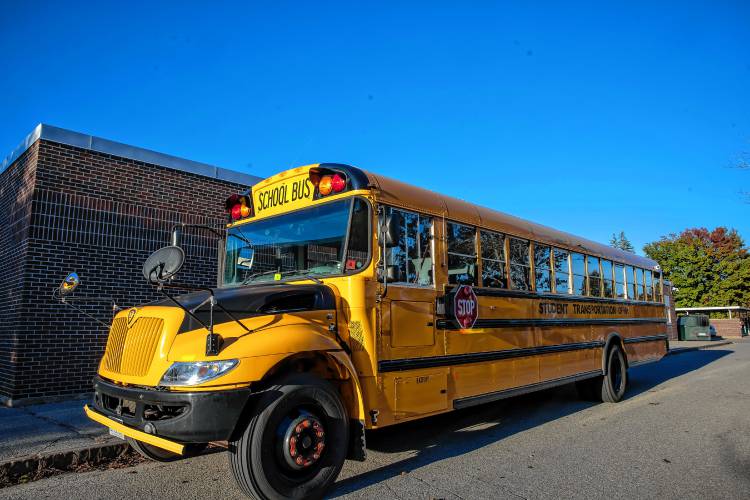Schools in Lakes Region explore creating a special education school to bring down costs

A Concord School District bus in front of Rundlett Middle School. GEOFF FORESTER
|
Published: 04-02-2025 6:07 PM
Modified: 04-02-2025 8:47 PM |
Plagued by rising special education costs, area school districts are considering joining forces to form a new special education school or centralize their services in other ways, according to several area administrators.
The discussions between roughly 20 school districts began this school year and are still in a preliminary phase, but administrators are expected to broach the prospect of a more formal exploration process with their school boards in the coming weeks, according to Jessica Bickford, the assistant superintendent of student services for the school administrative unit composed of Pembroke, Allenstown, Chichester, Epsom, and Deerfield.
One option districts are considering would involve establishing a new school that would serve certain students in Lakes Region communities who currently attend a variety of out-of-district placements. Consolidating students in one relatively centralized location could save member school districts operating and transportation expenses and reduce students’ daily commutes.
This collaborative model is common in Massachusetts, where 24 such schools receive students from multiple districts, but unusual in New Hampshire. Administrators interviewed knew of only two collaborative-like organizations in the state, the Seacoast Learning Collaborative in Newton and the Strafford Learning Center in Somersworth.
Administrators say they are also considering a slightly less ambitious option: rather than creating a new school, they could establish a centralized organization for sharing in-district special education services, which would reduce their reliance on expensive contracted services. That approach currently exists in the North Country, where 11 school administrative units have formed a consortium.
The districts involved in the preliminary meetings have included Concord, Merrimack Valley, Franklin, Tilton, Laconia, Pembroke, Allenstown, Chichester, Epsom, and Deerfield, among others, according to administrators, who stressed that no decisions have been made.
“We’re basically in an exploratory phase of trying to figure out what districts might need,” Bickford said in an interview.
The amount districts spend on special education costs has grown significantly in the last five years, driven both by increases in the number of students who require services and by the dearth of eligible employees available to provide them. The inability of districts to hire their own employees increasingly forces them to contract with external companies, who can charge more than double what the district itself would pay, Merrimack Valley Director of Student Support Services Julie Gaudette said at a meeting in February.
Article continues after...
Yesterday's Most Read Articles
 ‘There was no oversight’: NH child advocate has been a watchdog for children's care. Now, the office is on the chopping block
‘There was no oversight’: NH child advocate has been a watchdog for children's care. Now, the office is on the chopping block
 Volunteer group wants to help homeless clean up their camp
Volunteer group wants to help homeless clean up their camp
 ‘Less finger pointing, more communication’: Longtime Chichester residents share hopes before second town meeting
‘Less finger pointing, more communication’: Longtime Chichester residents share hopes before second town meeting
 Casella Waste Systems’ landfill project in New Hampshire’s North Country denied permit
Casella Waste Systems’ landfill project in New Hampshire’s North Country denied permit
 New Healthy Buffalo owner to build market in Chichester
New Healthy Buffalo owner to build market in Chichester
 ‘It’s everything’: In largest rally yet, Trump protestors descend on Concord
‘It’s everything’: In largest rally yet, Trump protestors descend on Concord
When districts can’t provide services in their buildings, they send their students to private special education schools that can cost up to six figures per year and could be located up to an hour away. The cost of transporting students has become a common driver of budget increases.
Patrice Chandler and Kathleen Harris, the co-directors of the Seacoast Learning Collaborative, which has existed since the 1980s, were unsure if a similar model would save Lakes Region districts money.
The co-directors said that the state sets the rates for certain special education services at each school. This school year, the cost of tuition at the collaborative was $43,147.80 for 180 days. An apples-to-apples comparison is challenging because schools vary in the services they offer, but tuition for 180-day programs ranges from $26,000 to $86,000, according to data from the Department of Education.
The Seacoast collaborative, which can serve up to 70 students, once had specific agreements with member schools but now is open to any district and operates largely like any other special education school in the state, though the superintendents of nine Seacoast school districts serve on its board, Chandler and Harris said in an interview.
While district administrators expressed some optimism that consolidation could lessen certain expenses, they also recognized it likely won’t be a silver bullet.
“One of the major barriers is staffing,” said John Fabrizio, Concord’s assistant superintendent of student services. “We can build it, but can we staff it?”
In addition to hiring the student-facing employees, a collaborative would also need a director and administrative support, and Fabrizio wondered whether the concept would ultimately be cost-effective.
The answer to that question could vary from district to district.
Fabrizio said that Concord – because of its size – would likely not benefit from the other option under consideration, which would involve sharing employees who provide in-district services.
“I need full-time people here because I have the numbers and the masses with the number of kids that we have identified,” Fabrizio said. “Smaller districts don’t need full-time [occupational therapy], [physical therapy], speech, and things like that because they don’t have the numbers. So that’s more advantageous to them probably than us, just because of pure number of students.”
Bickford, who directs services for five districts that each have school-aged populations of under 1,000, expressed more interest in that component of a consolidation.
“Speech, behavioral therapy, those kind of services would be helpful to have centrally located that we could potentially buy into at a cheaper rate versus having to go with a private contractor,” Bickford said.
She expressed some reservations, however, about the benefits of a collaborative school for her communities.
“I don’t know that we need anything placement-wise right now,” she said. “…We are focused on bringing our kids back as much as possible for a variety of reasons.”
When Gaudette, the Merrimack Valley administrator, shared the prospect of her district participating in a collaborative school at the annual meeting last month, she received similar feedback.
“Be very careful when you start talking about grouping special education students into a separate education or a special school,” said Annette Kowalczyk of Loudon. “For everybody else who feels that that’s where those kids should be, you are absolutely incorrect.”
Gaudette declined an interview request. It is not clear how, if at all, the creation of a collaborative would affect the total number of students who are educated outside of their districts.
Jeremy Margolis can be contacted at jmargolis@cmonitor.com.







 Henniker ponders what is a ‘need’ and what is a ‘want’
Henniker ponders what is a ‘need’ and what is a ‘want’ Boscawen residents vote to fund major renovation of public works building
Boscawen residents vote to fund major renovation of public works building ‘Voting our wallets’: Loudon residents vote overwhelmingly against $1.7M bond for new fire truck
‘Voting our wallets’: Loudon residents vote overwhelmingly against $1.7M bond for new fire truck In Pembroke, Education Freedom Accounts draw debate, voters pass budget
In Pembroke, Education Freedom Accounts draw debate, voters pass budget
